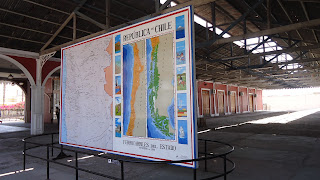History of Ferrocarril, Iquique, Chile
Located in Sotomayor street with Vivar, its construction dates from 1871, and is characterized by its original architectural style. It includes the Administration and Platform building. It was inaugurated on July 28, 1871, it was the Central station of the nitrate railway from Iquique to La Noria. This railway was built shortly before the Pacific War in territories that were still Peruvian in those days. Its builders, Ramón Montero and Hermanos, obtained from the state of Peru, on July 11, 1868, a concession to build a railway from Iquique to the nitrate field of La Noria.
Then, on May 18, 1869, they were authorized to build a line from Pisagua to Negreiros and finally on October 26, 1871, they were granted the concession to build a road that would connect the two previous ones.
In 1873, the railroad, built with Stephenson's standard gauge (1,435), was transferred to the National Saltpeter Railways of Peru, which later became The Nitrate Railways Company Limited. In 1887, after the War of the Pacific, all these territories were under Chilean sovereignty. Faced with the uncertainty that Chile would recognize the terms of the concession granted by Peru to the Monteros, they sold the majority of the railroad shares to John Thomas North at a much lower price than the real one. In 1890, Mr. North built a new branch to the south, reaching Pintados and Lagunas.
Among the main difficulties that the Monteros had to face during their construction, was the difficult ascent from sea level to a height close to 1000 meters in just a few tens of kilometers.
In the section from Iquique to La Noria, there was a section of approximately 18 kms. with a steep slope of 4%, so it was necessary to buy Double Fairlie-type locomotives in England, thanks to which it was possible to drag 150-ton trains on the aforementioned slope.
In 1926 three articulated locomotives of the Beyer-Garratt type were commissioned, which were assigned to the Iquique - Las Carpas section. Then, in 1928, two more were acquired, even though by then the nitrate industry was already beginning to decline.
Impressive Beyer Garratt-type locomotive:
Its strategic location in the area quickly turned the "Nitrate Railway" into a monopoly company, obtaining very important profits for many years.
Precisely to break this monopoly, the State of Chile authorized in 1914 the construction of a fiscal railway with a 1-meter gauge, between Pintados and Iquique, which could only start operations 14 years later, in 1928.
The Nitrate Railway had been born from several concessions of different dates, which gradually expired from 1936, beginning with that of Iquique to La Noria. For some years the company continued operating on the road and paying a toll to the State, although around 1950 it ceased to have an interest in its exploitation, for which reason it sold the lines and equipment to the State Railways, which formally received them in September from 1951.
Steam railcar of the type existing on this railway:
The State was in charge of maintaining the services to the nitrate offices that were still in operation: Prosperidad, Humberstone, Peña Chica, Mapocho, Victoria, Santa Rosa, Keryma, San Enrique, Iris and Alianza. Since the State took over the road, the section from Pintados to Iquique was converted to the metric gauge, leaving the "fiscal" route and directing the trains through the route of the old Salitrero Railway.
Once the gauge was changed, most of the Stephenson gauge gauge rolling stock was dismantled, including a beautiful steam railcar.





কোন মন্তব্য নেই:
একটি মন্তব্য পোস্ট করুন